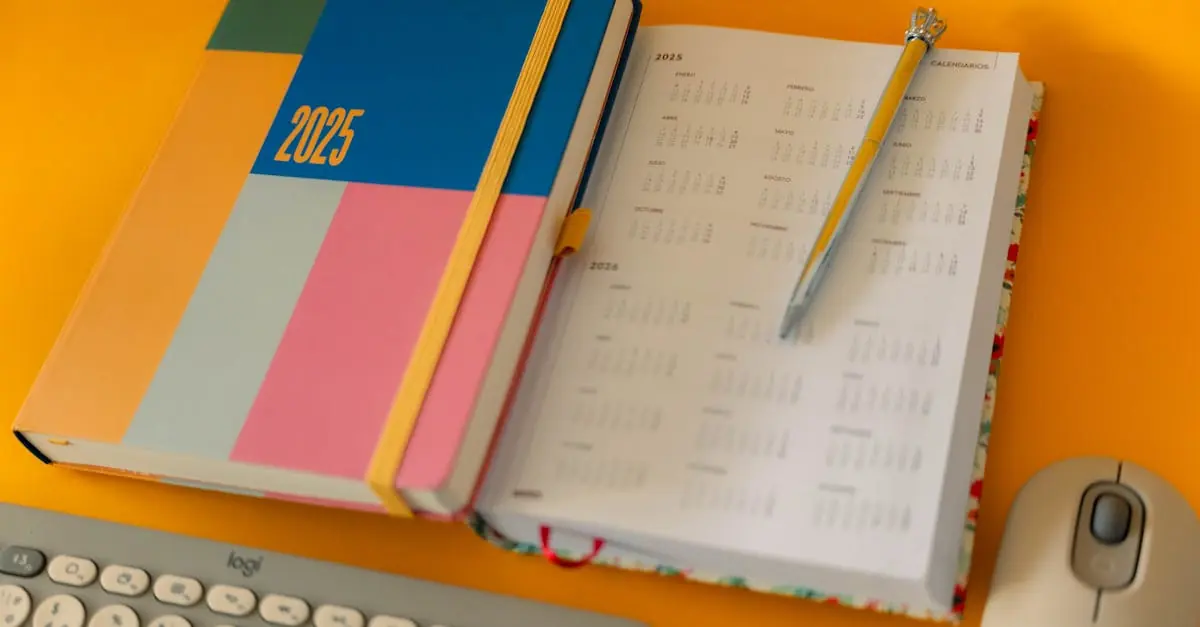Table of Contents
ToggleIn a world where language evolves faster than a cat meme goes viral, keeping track of daily linguistic quirks can feel like a full-time job. Enter the daily language log—a quirky tool that turns the mundane into the memorable. Imagine documenting those hilarious typos, the slang that makes you question your sanity, and the new words that slip into your vocabulary like uninvited guests at a party.
By maintaining a daily language log, one can not only sharpen their communication skills but also embrace the delightful chaos of language. It’s like having a personal diary for words, where each entry is a chance to reflect on the beauty and absurdity of human expression. So grab a notebook and get ready to capture the linguistic gems that pop up in everyday life—because who wouldn’t want to turn their verbal slip-ups into a treasure trove of amusement?
Overview of Daily Language Log
A daily language log serves as a creative outlet for documenting unique language experiences. This tool highlights the significance of recording various forms of communication encountered throughout the day. Individuals often track amusing typos, evolving slang, and newly coined expressions. Such logs foster a deeper appreciation for the complexity of language.
Keeping a language log encourages reflection on the nuances of everyday conversations. Individuals notice patterns in their communication habits, which enhances both comprehension and expression. They can use this log to explore the quirky aspects of language that may otherwise go unnoticed.
In addition to capturing unique moments, the daily language log serves as a practical resource. It helps individuals expand their vocabulary by noting unfamiliar words and phrases. Regular entries can lead to improved writing skills and a more diverse linguistic repertoire.
Crucially, a language log can act as a mirror, reflecting personal growth in communication. Participants can revisit past entries, identifying changes in language use over time. This process not only reinforces language retention but also nurtures a love for linguistic exploration.
Ultimately, maintaining a daily language log transforms mundane interactions into rich, engaging experiences. By prioritizing expression and creativity, anyone can turn ordinary language moments into extraordinary insights.
Benefits of Using a Daily Language Log
Using a daily language log provides valuable advantages that contribute to overall communication proficiency. These benefits surface as individuals engage with language on a deeper level.
Improved Language Skills
Tracking language nuances leads to enhanced vocabulary acquisition. Individuals frequently encounter new words and phrases, which fosters a more expansive language repertoire. Recognizing patterns in grammar and usage boosts comprehension skills. Recording typos and misused expressions offers immediate opportunities for correction. Continued reflection on past entries uncovers personal growth in linguistic abilities. Engaging with diverse forms of communication, such as slang and idioms, enriches understanding and application. Noticing frequent habits and unique expressions aids in refining style and clarity.
Enhanced Writing Practice
Writing in a daily log cultivates stronger writing habits. Consistency in practice leads to improved fluency and confidence. Experimenting with different genres creates versatility in expression. Setting aside time encourages exploration of various writing techniques. Observing the language of others serves as inspiration for personal writing styles. Regular entries transform initial raw thoughts into polished observations. Evaluating past entries reveals progress and shifting perspectives. Integrating feedback from peers enriches the overall writing experience.
How to Maintain a Daily Language Log
Maintaining a daily language log involves setting clear objectives and selecting an effective format. This practice turns everyday observations into valuable insights.
Setting Your Goals
Define what you want to achieve with your log. Individuals might focus on enhancing vocabulary, tracking language trends, or documenting amusing interactions. Establishing specific targets fosters motivation. For example, one might aim to add three new words each week. Others may prioritize documenting unique phrases or slang encountered daily. Phrasing goals distinctly helps maintain focus. Regular evaluations of these objectives informs progress and encourages adjustments, enhancing overall effectiveness.
Choosing the Right Format
Selecting an appropriate format influences the log’s usability. Many people prefer traditional notebooks for their tactile nature. Digital formats, however, allow for easy organization and retrieval. Various applications cater to language logging, offering features like tagging and search functions. Choose a format that fits lifestyle and preferences. Some individuals opt for a combination, using notebooks for on-the-go entries and digital options for comprehensive tracking. Ultimately, the best format simplifies the process, making it enjoyable and efficient.
Tips for Successful Daily Language Logging
Daily language logging thrives on consistent practice and reflection. Emphasizing these elements guarantees a richer experience.
Consistency is Key
Sticking to a regular schedule enhances the language logging process. Setting aside time each day for entries strengthens the habit. Most people find committing to the same time each day, such as morning or evening, helpful. Maintaining this routine leads to notices of patterns and improvements that emerge over time. Daily entries don’t require lengthy descriptions; even brief notes capture moments effectively. As consistency builds, the log transitions from a simple task to an enjoyable ritual.
Reflecting on Your Entries
Taking time to review past entries provides valuable insights. Reflecting on the content encourages growth in communication skills. Each entry highlights specific language challenges, amusing interactions, or new vocabulary, fostering awareness. Individuals often discover trends in grammar, word usage, or recurring themes. Noting these patterns informs future language choices and enriches overall expression. Additionally, revisiting past entries showcases progress, revealing how language use evolves over time. This practice not only reinforces learning but also sparks creativity for future logging sessions.
A daily language log is more than just a record; it’s a gateway to understanding the intricacies of communication. By embracing this practice, individuals can uncover the humor and uniqueness of language in their daily lives.
The benefits extend beyond mere documentation, fostering growth in vocabulary, writing skills, and overall communication proficiency. Regular reflections on past entries not only highlight progress but also inspire creativity in language use.
Starting a daily language log can transform ordinary interactions into insightful experiences, making it an invaluable tool for anyone looking to enhance their linguistic journey.







